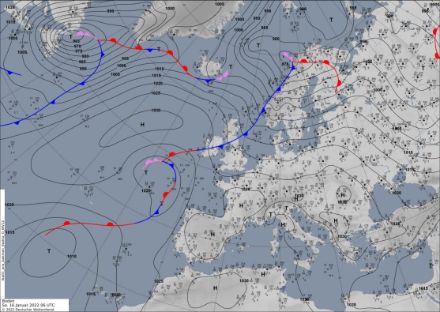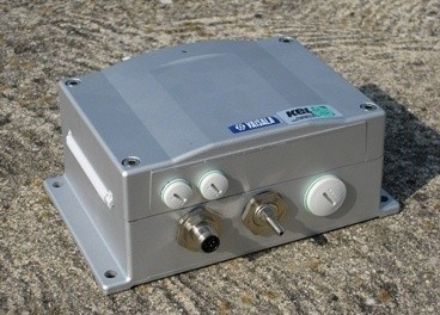Service Navigation
Search
Air pressure is closely linked to the weather situation. An area of high pressure is under high atmospheric pressure and is generally sunny, while an area of low pressure is under low atmospheric pressure and is cloudy. The differences in atmospheric pressure are also dependent on the direction and speed of the wind.
Air pressure is measured in hectopascal (hPa), which gives the weight of the air column that extends from the ground up to the upper boundary of the atmosphere. For example, if a location has an air pressure of 1,000 hPa, the air has a weight of about 10 tonnes over an area of one square meter. Air pressure is depicted on maps in the form of isobars, i.e. lines of equal air pressure.

The influence of elevation on air pressure
As elevation increases, air pressure decreases because the column of air above the location in question is shorter and therefore weighs less. At sea level, the average air pressure is around 1,013 hPa. At 1,500 m above sea level, the pressure is only 850 hPa, and at 5,500 m it is around 500 hPa. Because air can be compressed, air pressure does not decrease in a linear fashion with elevation. The density of the air is high when the air pressure is high. In other words, the air is heavily compressed. This is the situation that exists close to the ground. As elevation increases, the air becomes thinner and therefore less dense.
At what point is air pressure described as either “high” or “low”?
In Switzerland, the multi-year average air pressure (reduced to sea level, QFF) is about 1,018 hPa. One might therefore say that values above that level correspond to high pressure and values below it to low pressure. But that is not necessarily the case. Rather than the absolute pressure value, it is much more important to look at the relative distribution of the air pressure. For this, it is necessary to consider the pressure distribution over a wider area. Wherever the highest pressure is measured is described as an area of high pressure – regardless of the absolute values. This could apply to a pressure of as little as 1,015 hPa. However, typical values for an area of high pressure in Switzerland are around 1,034 hPa in winter or from about 1,023 hPa in summer.
The highest values of air pressure reduced to sea level (QFF) across Switzerland are around 1,048 hPa. Worldwide, the absolute record for the highest air pressure is 1,084.8 hPa, as measured on 19 December 2001 in Tosontsengel, Mongolia. Given that this value originates from an elevation of 1,725 m above sea level and considerable correction was therefore involved in the reduction to sea level, the WMO lists another record, which is limited to measurements from elevations of less than 750 m.a.s.l. This record is 1,083.3 hPa, as measured on 31 December 1968 in Agata, Siberia.
| Summer | Winter | |
|---|---|---|
| Very strong high | 1028 hPa | 1047 hPa |
| Typical high | 1023 hPa | 1034 hPa |
| Mean value | 1017 hPa | 1020 hPa |
| Typical low | 1010 hPa | 1001 hPa |
| Very strong low | 1000 hPa | 973 hPa |
Typical air-pressure values, as observed in Switzerland in summer and winter. (© MeteoSwiss)
Adjusting air pressure to sea level
In order to be able to compare the air pressures measured at different locations, the influence of elevation must be excluded from the calculation (in the technical jargon, this is known as reduction). In other words, the air pressure is converted to the equivalent air pressure at a station at sea level. The resulting value is what the pressure would be if the weather station were at sea level. This allows us to identify regional air-pressure differences.
Air pressure is not just air pressure. There are three different ways it can be represented:
- QFE is used to denote the air pressure measured at a ground-level weather station.
- QFF is used to denote the air pressure at the monitoring station when reduced to sea level.
- QNH is used to denote the air pressure at a ground-level weather station reduced to sea level according to the “standard atmosphere”.
Based on the recommendations of the World Meteorological Organization (WMO), air-pressure measurements are reduced to sea-level at stations with an elevation of less than 600 m.a.s.l. Stations at higher elevations are reduced to the meteorological standard pressure areas of 850 or 700 hPa.
When reducing to sea-level, assumptions must be made about the density of the atmosphere between the station elevation and sea-level. It is standard meteorological practice to automatically factor in the temperature measured at the station. The resulting atmospheric pressure value at sea-level is called the QFF. The prevailing humidity is not included in the calculations for Switzerland.
In aviation, the station pressure is reduced to sea level independently of the current weather conditions. The vertical density distribution is uniform according to the ICAO standard atmosphere. The resulting atmospheric pressure value at sea-level is called the QNH.
How air pressure is measured

Air pressure is measured at ground-level weather stations in the automatic monitoring network operated by MeteoSwiss. The atmospheric pressure is measured using a digital pressure measuring device produced by Vaisala. These devices (PTB330) are known for their high level of stability and accuracy. The PTB330 has three redundant BAROCAP® sensors, which guarantee high-quality measurements and outstanding reliability.